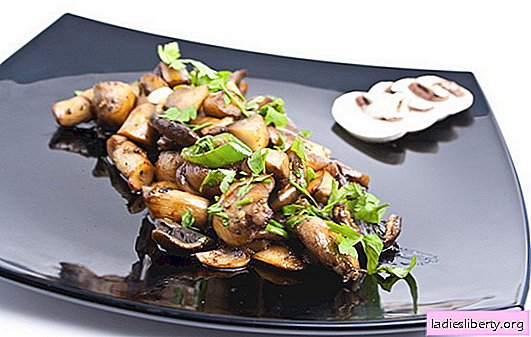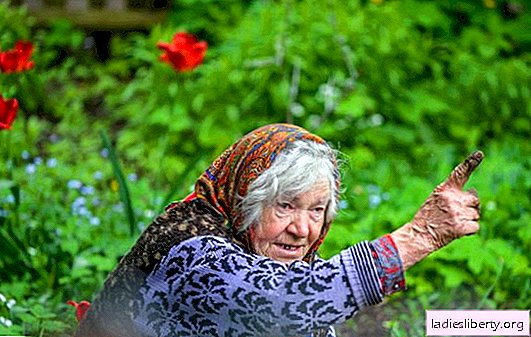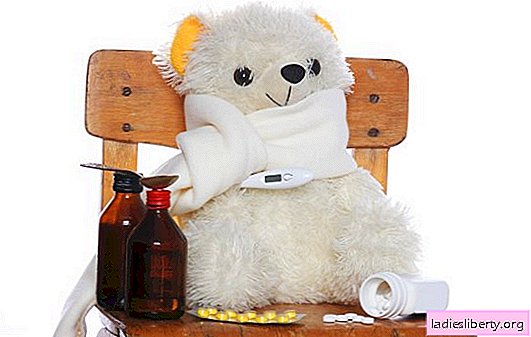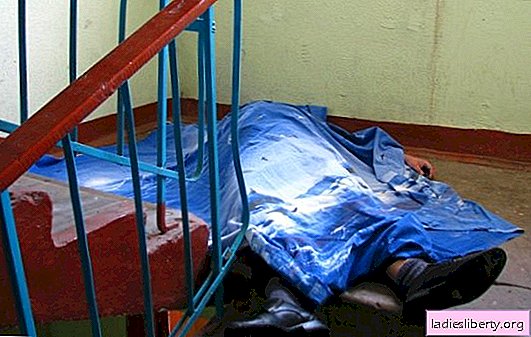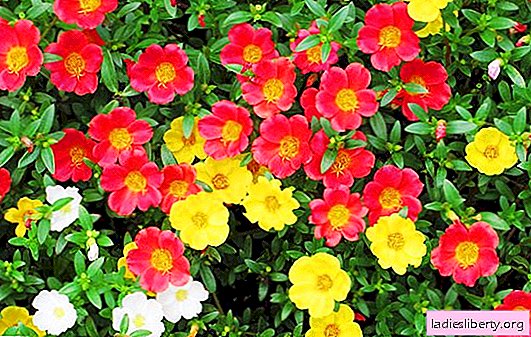
To diversify a flower bed, give it a bright color will help the plant purslane. Florists often use it when creating alpine slides. Unusual flowers stand out against the backdrop of natural greenery, which makes the plant in demand in landscape design.
Plant characteristics
Purslane is an annual plant, creeping shoots are covered with a variety of bright colors that have a simple or terry shape.
The herbaceous plant reaches a height of 10 to 20 cm. The stems branch well, have succulent flattened leaves. The leaf color is green. Purslane flowering occurs in the spring, usually in May and lasts until September. Purslane is grown in open ground, flowerpots and flower pots.
Cultivation of purslane: varieties and species (photo)
The genus Portulakova has about 100 species of plants. In modern floriculture, only one species of purslane is grown - large-flowered. This is a perennial plant, which in our latitudes is cultivated as an annual. Flowers reach a diameter of about 6 cm, there are terry varieties. Their color ranges from white to red, there are no blue varieties. Sometimes flowers with a double color are found. Terry varieties of purslane produce much less seeds, which makes their cultivation difficult.
1. Purslane Macovei - This variety can be used as food. The bush is medium-sized, reaches a height of about 30 cm. Young shoots, the age of which does not exceed one month from seedlings, are used in cooking.

2. Purslane Cherry - a decorative undersized variety, the height of the bush varies within 15 cm. The leaves of the plant are needle-shaped, and the flowers are large, terry-shaped. Coloring flowers cherry.

3. Purslane Flamenco - has large fleshy shoots with juicy leaves. The color of the leaves is bright green. Terry flowers of various colors appear until late autumn.

Purslane: planting and care of ornamental plants
Location selection
An unusual plant prefers sunny places and light partial shade. Under such conditions, purslane flowers open in the morning. In a thick shadow, he feels bad, flowering becomes very sparse. So, choosing a place for planting a plant, you need to take care of its illumination during the day.
The soil
Purslane grows very well on poor soils with sufficient sand content. Fertilized soil contributes to the growth of greenery at the expense of flowering.
To grow purslane, you need to select a dry area, without stagnation of water. If the soil is too wet, the root system may get wet.
Watering
The plant does not need frequent watering, tolerates drought. It needs loosening the soil only after planting. It should be remembered that excess soil moisture contributes to the development of fungal diseases. With proper care, the bush is not affected by pests and is resistant to many diseases.
Fertilizers
Decorative varieties of purslane do not need top dressing. Too nutritious soil inhibits flowering. But those varieties that are grown for culinary purposes can be regularly fertilized. For this, liquid mineral complexes are used, which contribute to a good growth of green mass. Feeding should be done once a month. The first time purslane is fertilized after emergence.
Caring for purslane is quite simple, it is enough to adhere to all of the above rules, and the plant will always appreciate a long, bright flowering.
We grow purslane: reproduction (photo)
An unusual plant can be propagated in several ways:
• seeds;
• cuttings.
Seed propagation
Most often in our latitudes, purslane is grown through seedlings. To do this, the seeds are sown in late February - early March. Tanks for growing should have a hole for draining excess fluid. The soil should be well drained. Seeds are laid out on the surface of the soil without sprinkling them with earth. Purslane needs light to germinate.
Advice! Every year it is necessary to purchase new seeds for planting. Seeds collected from plants are unsuitable for further cultivation. Hybrid varieties do not always germinate, and flowering will not bring the expected results.
Seed containers should be placed in the greenhouse until the first seedlings appear. The temperature for germination should not fall below +20 degrees.
The first shoots can appear only after 14 days. Seedlings are well looked after, watered, trying not to moisten the soil too much. A pick is done when the plants grow a little, reaching a height of about 3 cm.

It is possible to plant young seedlings in a flower bed or in a pot only when a constant temperature is established. Even a slight prolonged cold snap of up to +10 degrees can destroy still immature plants.
In the southern regions of the country, purslane sowing can be carried out immediately in rows. To do this, the soil is compacted, well moistened and seeds are evenly distributed. Landings must be covered with a film. When seedlings appear, the covering material is removed. Seedlings need constant care: it is necessary to loosen the soil, remove weeds and inspect the plants. When the plants get stronger, thinning should be carried out, leaving several seedlings at a distance of about 20 cm.
Important! Purslane seeds retain their germination for three years.
It is possible to collect seeds only from ordinary plants, terry forms of purslane are the result of selection, grown plants do not repeat all parental qualities. In simple plants, collecting boxes with seeds must be carried out as they ripen, preventing self-seeding, otherwise they will hatch in the warm autumn weather and die in the winter.
Propagation by cuttings

Wanting to keep the favorite variety, you can resort to cuttings of the purslane. For this, the plant is dug up and transferred to the premises for wintering. And already in the spring they carry out cuttings.
The mother plant is cut into cuttings that are well rooted in water. Young bushes are planted in a permanent place in May, when the weather permits. The seedlings obtained in this way begin to bloom a month after planting.
Purslane diseases and pests
The plant is very resistant to various diseases and pests. However, if the rules for growing purslane are not followed, some of them may be affected.
1. Fungal diseases.
Most often, the plant becomes infected in rainy summers, with severe overmoistening of the soil. The first signs of the disease can be recognized by the appearance of the bush. Spoiled buds and stains on young leaves should alert the gardener.
At the first symptoms, treatment should be carried out. All damaged buds and shoots are removed, and the plant is treated with preparations containing copper.
2. Aphids on purslane leaves.
If the garden is invaded by aphids, then it will certainly settle on the succulent leaves of the plant. If a pest is found, you need to spray the bush with soapy water. If such methods did not help, then apply the treatment with a solution of potassium permanganate.
3. Thrips.
At the very beginning of the growing season, young seedlings are prone to thrips attack. They can be found by small silver dots on the leaves. You need to fight the parasite with the help of chemicals.
Gardeners fell in love with purslane for its unpretentiousness and ease of cultivation. The variety of colors and the continuity of flowering - these are the main advantages of the plant, which will decorate any corner of the garden.

